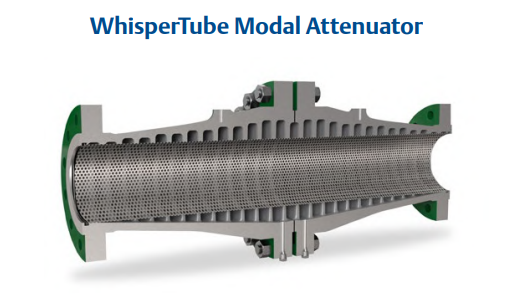Many industrial processes are quite loud from the flow of fluids through the piping, especially where there are changes in the flow rate. In a Hydrocarbon Engineering article, Sound Suppression, Emerson’s Bill Flowers shares ways to reduce high noise conditions caused by control valves and surrounding piping.
Bill opens sharing Lighthill’s law, which states:
…that aerodynamic noise varies as the eighth power of the gas velocity, so high flow and high pressure drop applications get very loud, very quickly. Most plants address high control valve noise in one of two methods, either source control or path control. Each method has varying levels of cost and effectiveness.
Source control:
…is often accomplished using pressure drop staging or flow division. Pressure drop staging reduces the overall sound by dividing the total pressure drop over a number of steps, rather than taking the full drop in at a single point.
Ways to address source control is:
…with a multistage low noise valve trim design, or it can include pressure reducing inline diffusers on the inlet and/or outlet to reduce the overall pressure drop through the valve itself…
Another source control approach is flow division, which:
…breaks up the single flow path into multiple flow paths, thus reducing the overall velocity of each path. The reduced velocity results in lower levels of sound.
Path control suppresses sound by muffling:
…the sound and keep it from radiating to the surrounding area. The techniques can be as simple as thick walled pipe, pipe insulation, or encasing the pipe with acoustic blankets or materials designed to absorb the sound. Alternatively, one can employ specially designed silencers which either absorb the sound or use resonant chambers to cancel the noise through destructive interference.
Bill highlights the downside of each of the two approaches.
Both source and path controls do work, but they come with significant costs and limitations. Low noise valve trims usually require a more expensive globe valve, and its intricate internals raise the valve price considerably. Silencers and diffusers add pressure drop by design and their peak performance can be limited to certain ranges of flow. None of these options are capable of passing a pipeline pig, so a pig capture and bypass chamber are required.
 Read the article for more on alternatives which have emerged including modal coincidence suppression and how additive manufacturing and 3D metal printing have enabled model suppression devices, such as the Fisher WhisperTube.
Read the article for more on alternatives which have emerged including modal coincidence suppression and how additive manufacturing and 3D metal printing have enabled model suppression devices, such as the Fisher WhisperTube.
Also, read the Effective solutions for preventing control valve noise on Emerson.com for more on the WhisperTube Modal Attenuator which offers full bore aerodynamic noise reduction for all sources upstream, with no impact on process flow as well as other noise attenuating solutions.





